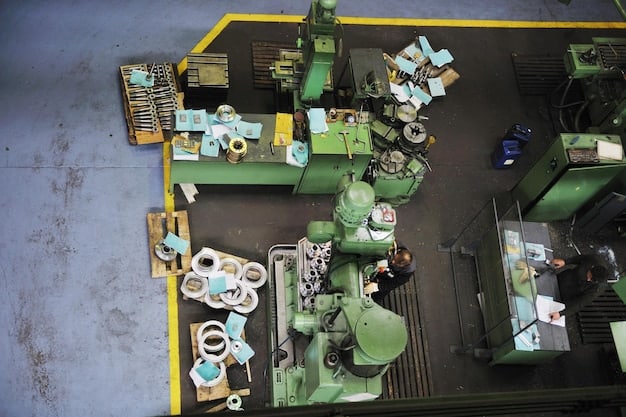Waste Management: Increasing Recycling Rates and Reducing Landfill Waste in US

Understanding the science of waste management is crucial for US communities aiming to increase recycling rates and reduce landfill waste by 30%, requiring a multifaceted approach encompassing education, infrastructure improvements, and policy changes.
Are you concerned about the growing piles of waste in our landfills? Understanding the science behind waste management: How can US communities increase recycling rates and reduce landfill waste by 30%? is the first step towards creating a more sustainable future. Let’s explore some actionable strategies and insights.
Understanding the Basics of Waste Management
Waste management is more than just collecting trash; it’s a comprehensive system designed to minimize the environmental impact of waste. It involves various stages, from collection and transportation to processing and disposal.
Effective waste management reduces pollution, conserves resources, and protects public health. By understanding the science behind it, communities can make informed decisions and implement effective strategies.
The Hierarchy of Waste Management
The waste management hierarchy prioritizes strategies from most to least environmentally sound. This hierarchy serves as a guiding principle for sustainable waste management practices.
- Reduce: Minimizing the amount of waste generated in the first place.
- Reuse: Finding new uses for items instead of discarding them.
- Recycle: Processing waste materials into new products.
- Recover: Capturing energy from waste through incineration or other means.
- Dispose: Safely disposing of waste in landfills as a last resort.
Understanding this hierarchy helps communities prioritize waste management strategies that have the greatest positive impact on the environment and resource conservation.
Ultimately, a holistic approach to waste management requires understanding the interconnections between these stages and implementing strategies that address each level effectively.

The Role of Recycling in Waste Reduction
Recycling is a key component of waste management. By diverting materials from landfills and turning them into new products, recycling helps conserve resources and reduce pollution.
However, recycling programs can only be effective when communities understand what can and cannot be recycled. Without proper sorting and education, recycling efforts can be undermined.
Commonly Recycled Materials
While recycling programs vary by location, some materials are commonly accepted across the US. Knowing what to recycle is essential for maximizing waste diversion.
- Paper: Newspapers, magazines, cardboard, and office paper are widely recyclable.
- Plastic: Certain types of plastic bottles and containers can be recycled.
- Glass: Glass bottles and jars are typically recyclable.
- Metal: Aluminum cans, steel cans, and other metal products can be recycled.
Ensuring materials are clean and free of contaminants is crucial for successful recycling. Contaminated materials can spoil entire batches of recyclables.
Recycling is not a one-size-fits-all solution. To increase recycling rates, communities need to tailor their programs to local needs and resources.
Overcoming Barriers to Higher Recycling Rates
Despite the benefits of recycling, many communities struggle to achieve high recycling rates. Several barriers hinder progress, including lack of public awareness, inadequate infrastructure, and economic factors.
Addressing these barriers requires a collaborative effort involving governments, businesses, and residents. By working together, communities can create more effective recycling programs.
Lack of Public Awareness and Education
Many people are unaware of the importance of recycling or don’t know what materials can be recycled. Often, people believe recycling is a hassle without understanding the broader environmental benefits.
Comprehensive education programs can help raise awareness and encourage participation. When people understand the impact of their actions, they are more likely to recycle.
Infrastructure and Accessibility Issues
The availability of recycling facilities and convenient collection programs can significantly impact recycling rates. When recycling is easy and accessible, more people are likely to participate.
Investing in recycling infrastructure, such as curbside collection programs and drop-off centers, is essential for increasing recycling rates. Likewise, ensuring that multifamily housing has adequate recycling access is critical to improving overall diversion rates.

Strategies for US Communities to Increase Recycling
To achieve a 30% reduction in landfill waste and improve recycling rates, US communities can implement a range of strategies. These strategies include policy changes, infrastructure improvements, and community engagement initiatives.
Each community’s approach will depend on its unique circumstances and priorities. Finding a mix of strategies that work best for the local context is key.
Enhancing Public Awareness and Education
Education is the cornerstone of successful recycling programs. Informing residents about the benefits of recycling and how to properly sort materials can significantly increase participation rates.
Conducting targeted outreach campaigns, workshops, and school programs can promote recycling and reduce waste generation. Reaching diverse audiences with culturally relevant messages is essential.
Investing in Recycling Infrastructure
Upgrading recycling facilities and expanding collection programs can make recycling more convenient and efficient. This includes investing in technology to improve sorting processes and reduce contamination.
Providing curbside recycling bins to all households and establishing convenient drop-off centers can boost recycling rates. When recycling is easy and accessible, people are more likely to participate.
Policy and Regulatory Measures
Policy and regulatory measures play a crucial role in promoting waste reduction and recycling. Governments can implement policies that incentivize recycling, discourage waste generation, and hold producers responsible for the end-of-life management of their products.
These policies can create a supportive environment for sustainable waste management and help communities achieve their recycling goals.
Extended Producer Responsibility (EPR)
EPR policies require manufacturers to take responsibility for the collection, recycling, or disposal of their products. This incentivizes producers to design products that are easier to recycle or reuse.
EPR programs can be particularly effective for managing electronic waste, packaging, and other hard-to-recycle materials. By shifting the burden of waste management from municipalities to producers, EPR can drive innovation in product design and recycling technologies.
Waste Diversion Targets and Landfill Bans
Setting waste diversion targets provides a clear goal for communities to strive towards. Landfill bans prohibit certain materials from being disposed of in landfills, encouraging recycling and composting.
These measures can help reduce the amount of waste sent to landfills and promote more sustainable waste management practices. Clear, measurable goals and consistent enforcement are essential for the success of these policies.
Measuring Progress and Ensuring Accountability
To track progress and ensure accountability, communities need to establish metrics for measuring recycling rates and waste reduction. Regular monitoring and reporting can help identify areas for improvement and inform policy decisions.
Transparency and data-driven decision-making are essential for achieving sustainable waste management goals.
Key Performance Indicators (KPIs)
KPIs provide a way to measure the effectiveness of waste management programs. These indicators can help communities track progress and identify areas where they need to improve.
- Recycling Rate: The percentage of waste that is recycled rather than disposed of in landfills.
- Waste Diversion Rate: The percentage of waste that is diverted from landfills through recycling, composting, and other means.
- Per Capita Waste Generation: The amount of waste generated per person per year.
Collecting data on these KPIs and regularly reporting on progress can help communities stay on track towards their waste reduction goals. Celebrating successes and addressing shortcomings can motivate ongoing efforts.
Ultimately, a combination of strategies tailored to local needs, supported by strong policies and accountability mechanisms, is essential for achieving a 30% reduction in landfill waste and increasing recycling rates in US communities.
| Key Point | Brief Description |
|---|---|
| 🌱 Reduce Waste | Minimize waste generation through conscious consumption and waste reduction strategies. |
| ♻️ Improve Recycling | Boost recycling rates through better education, infrastructure, and policy. |
| 🏢 Policy Changes | Implement policies like EPR and landfill bans to drive sustainable waste management. |
| 📊 Measure Progress | Track recycling and waste diversion rates to ensure accountability and inform future decisions. |
Frequently Asked Questions (FAQ)
What is the waste management hierarchy?
▼
The waste management hierarchy prioritizes waste reduction, reuse, recycling, recovery, and disposal in that order, aiming to minimize environmental impact.
Why is recycling important?
▼
Recycling conserves resources, reduces pollution, and saves energy by transforming waste materials into new products.
What are some common barriers to higher recycling rates?
▼
Barriers include lack of public awareness, inadequate infrastructure, and economic factors that hinder effective recycling.
What policies can help increase recycling?
▼
Extended Producer Responsibility (EPR) and landfill bans are policies that incentivize recycling and discourage waste generation.





